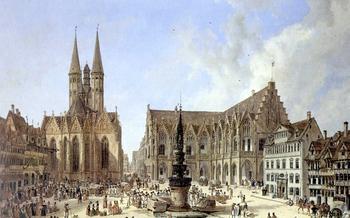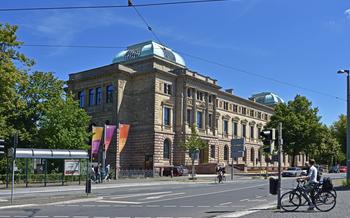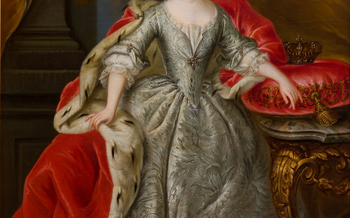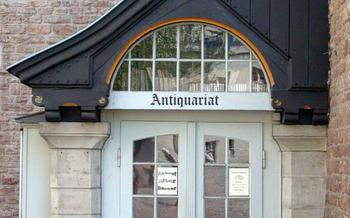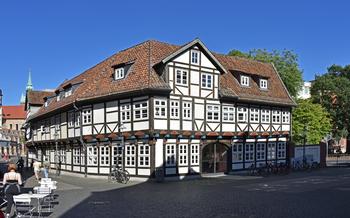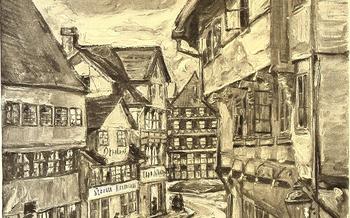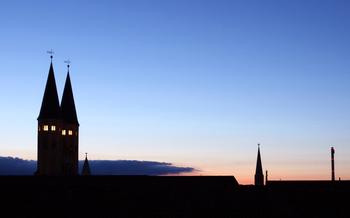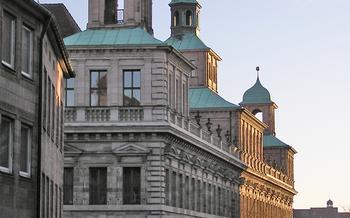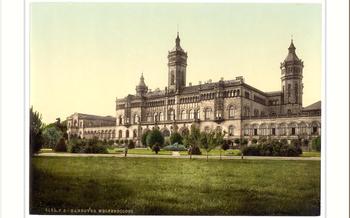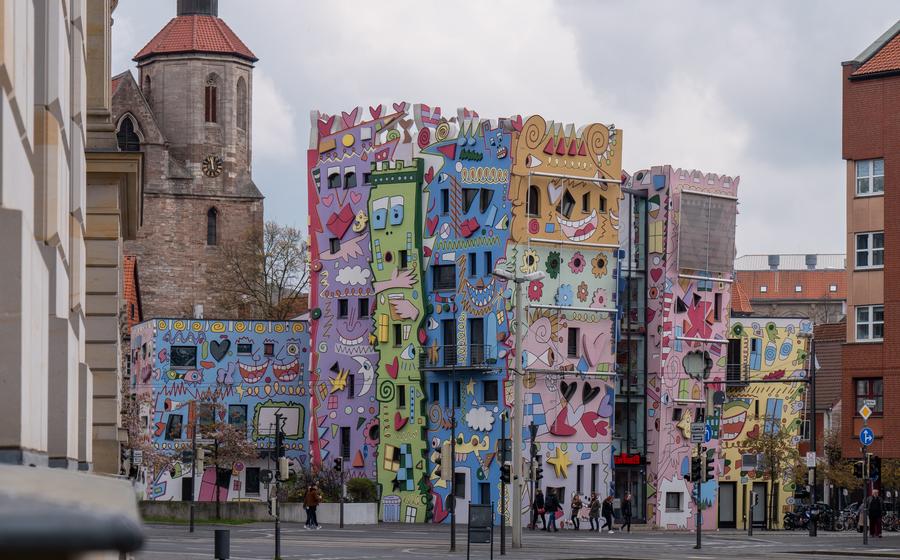
Happy Rizzi House
- A City of Contrasts
- The Happy Rizzi House: A Playful Masterpiece
- History
- Architecture
- Culture
- Anecdote
- Exploring the Facade: A Visual Feast
- A Walk Through Time: Braunschweig's Old Town
- The Ducal Palace: A Symbol of Power and Grandeur
- The Braunschweig Cathedral: A Gothic Masterpiece
- The Altstadtmarkt: The Heart of the City
- The Hagenmarkt: A Place of History and Commerce
- The Braunschweig State Museum: A Treasure Trove of Art and History
- The Technical Museum: A Journey Through Innovation
- The Natureum: A Celebration of the Natural World
- The Maschpark: An Oasis in the City
- Annual Festivals: A Time for Celebration
- The Braunschweig Christmas Market: A Festive Extravaganza
- Insider Tip: Discover the Hidden Gems
A City of Contrasts
Braunschweig, a city steeped in history, offers a captivating blend of medieval charm and modern sophistication. Wander through its cobblestone streets and admire the juxtaposition of Gothic Revival churches with sleek glass and steel structures. Explore architectural gems spanning Romanesque, Renaissance, and Baroque styles, showcasing the city's rich heritage. Immerse yourself in a vibrant art scene, with galleries and studios showcasing contemporary works, while traditional German customs and festivals keep the city's cultural traditions alive.
In my own experience, I stumbled upon a hidden courtyard nestled amidst the city's modern buildings. There, I discovered a charming café housed in a centuries-old half-timbered house, where I enjoyed a delicious traditional German breakfast while soaking in the city's unique atmosphere. The harmonious coexistence of old and new in Braunschweig creates a captivating tapestry that leaves visitors in awe.
The Happy Rizzi House: A Playful Masterpiece
History
The Happy Rizzi House, located in the heart of Braunschweig, is a vibrant and colorful building that stands out from the surrounding medieval architecture. It was designed by renowned pop artist James Rizzi, who was commissioned to create a unique and eye-catching facade for the building. Rizzi's vision was to create a playful and joyful artwork that would bring a smile to people's faces.
Architecture
The facade of the Happy Rizzi House is a masterpiece of pop art and graffiti. It features a riot of colors, whimsical characters, and geometric shapes that dance across the building's surface. Rizzi used bright and cheerful colors to create a sense of optimism and happiness. The characters on the facade represent different aspects of human nature, such as love, joy, and friendship.
Culture
The Happy Rizzi House is a symbol of Braunschweig's vibrant art scene. It has become a popular tourist attraction and a beloved landmark for locals. Rizzi's artwork has had a profound impact on the city's cultural identity, making it a more colorful and playful place.
Anecdote
During my visit to Braunschweig, I had the opportunity to meet a local resident who shared her thoughts on the Happy Rizzi House. She told me that she loves the building because it always makes her smile. She said that it reminds her of the simple joys in life and the power of art to transform a city.
Exploring the Facade: A Visual Feast
The facade of the Happy Rizzi House is a visual feast, a riot of colors and characters that captivates the eye and sparks the imagination. The building's exterior is adorned with a cast of whimsical characters, each with its own story to tell. There's the winking sun, the dancing couple, the playful dog, and the mischievous cat, among many others. These colorful figures seem to be frozen in motion, as if caught in a moment of joy and celebration.
The facade's vibrant colors and intricate details are a testament to Rizzi's artistic vision and his love for life. He used bold brushstrokes and bright hues to create a sense of movement and energy, making the building come alive with personality. The characters on the facade are not just decorative elements; they are symbols of happiness, diversity, and the interconnectedness of all living things.
Rizzi's facade is a unique and innovative work of art that has become an icon of Braunschweig. It is a reminder that architecture can be playful and whimsical, that buildings can tell stories, and that art has the power to transform the urban landscape.
A Walk Through Time: Braunschweig's Old Town
Braunschweig's Old Town, a testament to the city's rich history, invites visitors on a captivating journey through time. The cobblestone streets, lined with centuries-old buildings, exude an enchanting aura that transports you to a bygone era. History buffs will delight in exploring the numerous landmarks that dot the old town, each with its own unique story to tell.
The Dankwarderode Castle, a former residence of the Dukes of Brunswick, stands as a symbol of the city's medieval past. Its imposing presence, with its sturdy walls and towers, evokes images of knights and jousting tournaments.
The St. Martini Church, a magnificent Gothic masterpiece, boasts intricate carvings and soaring spires that reach towards the heavens. Step inside to marvel at the stunning stained-glass windows, which bathe the interior in a kaleidoscope of colors.
Anecdote: During my stroll through the old town, I stumbled upon a hidden gem tucked away in a quiet alleyway. The Georgenhof, a former monastery, has been transformed into a charming courtyard, where I enjoyed a peaceful respite from the bustling city streets.
Immerse yourself in Braunschweig's vibrant culture by attending one of the many festivals and events held throughout the year. From the lively Braunschweiger Altstadtfest to the enchanting Braunschweiger Weihnachtsmarkt, there's something for everyone to enjoy.
Whether you're a history enthusiast, an architecture buff, or simply someone who appreciates the charm of a well-preserved old town, Braunschweig has something to offer. Embrace the city's rich heritage as you wander through its ancient streets, discovering the stories that lie hidden within its walls.
The Ducal Palace: A Symbol of Power and Grandeur
The Ducal Palace, a majestic symbol of Braunschweig's rich history, stands proudly in the heart of the city. Its grand facade, adorned with intricate carvings and sculptures, speaks of the opulence and power of the Dukes of Brunswick, who once resided within its walls.
Step inside the palace and be transported back in time to an era of lavish banquets and courtly intrigue. The grand halls and opulent chambers, once graced by royalty, are a testament to the palace's former glory. Marvel at the intricate tapestries, the gleaming chandeliers, and the finely crafted furniture that adorn each room.
The palace's architectural highlights are a testament to the skill and artistry of its builders. The grand staircase, with its sweeping curves and ornate balustrades, is a masterpiece of Baroque design. The Mirror Room, with its walls lined with shimmering mirrors, creates an illusion of infinite space and reflects the grandeur of the palace's interior.
The Ducal Palace played a pivotal role in shaping Braunschweig's cultural identity. It was here that the Dukes hosted lavish parties and entertained guests from across Europe. The palace was also a center of learning and scholarship, with a library that housed a vast collection of books and manuscripts.
As you wander through the halls of the Ducal Palace, let your imagination run wild and picture the scenes that once unfolded within its walls. Imagine the Dukes and their court, dressed in elaborate finery, dancing and feasting in the grand ballroom. Imagine the scholars and artists, gathered in the library, discussing the latest ideas and discoveries.
The Ducal Palace is more than just a historical monument; it is a symbol of Braunschweig's rich heritage and a reminder of the city's former status as a center of power and culture. A visit to the palace is a must for anyone interested in exploring the city's past and discovering the stories that lie within its walls.
Anecdote:
During my visit to the Ducal Palace, I had the privilege of meeting a local historian who shared a fascinating tale about a royal encounter that took place within the palace walls. According to the historian, in the 18th century, the Duke of Brunswick hosted a grand ball in honor of a visiting prince from a neighboring kingdom. The ball was attended by all the city's elite, and the atmosphere was one of excitement and anticipation.
As the evening progressed, the Duke and the prince engaged in a lively conversation about politics, culture, and the latest advances in science. The prince was so impressed by the Duke's knowledge and eloquence that he declared him to be the wisest and most enlightened ruler he had ever met. The Duke, in turn, was flattered by the prince's praise and vowed to continue his efforts to make Braunschweig a center of learning and culture.
This anecdote not only highlights the significance of the Ducal Palace as a center of power and diplomacy but also sheds light on the intellectual and cultural achievements of the Dukes of Brunswick. Their patronage of the arts and sciences helped to transform Braunschweig into a vibrant and cosmopolitan city, and their legacy continues to inspire and fascinate visitors to this day.
The Braunschweig Cathedral: A Gothic Masterpiece
Standing as a testament to the city's rich history and architectural prowess, the Braunschweig Cathedral is a Gothic masterpiece that has captivated visitors for centuries. Its construction, spanning over several centuries from the 12th to the 15th, showcases the evolution of Gothic architecture and the dedication of its builders.
The cathedral's exterior is a symphony of Gothic elements, featuring intricate carvings, soaring spires, and flying buttresses. Its facade is adorned with sculptures depicting biblical scenes and historical figures, adding a layer of narrative to its architectural grandeur. The interior of the cathedral is equally impressive, with its lofty nave, ribbed vaults, and stained glass windows casting a kaleidoscope of colors.
Beyond its architectural significance, the Braunschweig Cathedral holds immense religious and spiritual value. It has served as a place of worship for centuries, witnessing countless baptisms, weddings, and funerals. The cathedral's acoustics are renowned for their clarity, making it an ideal venue for concerts and choral performances.
One unforgettable anecdote is attending a Christmas Eve service at the cathedral. The atmosphere was truly magical, with the choir's voices reverberating through the grand space, accompanied by the soft glow of candlelight. It was a moment of profound peace and reflection, surrounded by the beauty of this architectural masterpiece.
Whether you're a history buff, an architecture enthusiast, or simply seeking spiritual inspiration, the Braunschweig Cathedral is a must-visit destination. Its timeless beauty and rich history will leave an indelible mark on your memory.
The Altstadtmarkt: The Heart of the City
History
The Altstadtmarkt, or Old Town Market Square, is the heart of Braunschweig, throbbing with history and life. Since the 11th century, this bustling square has served as a market, a gathering place, and a witness to countless events that shaped the city's destiny.
Architecture
Towering over the square is the majestic Town Hall, a masterpiece of Gothic architecture. Its intricate facade, adorned with sculptures and carvings, tells tales of the city's past. The surrounding buildings, a harmonious blend of medieval and modern styles, add to the square's architectural charm.
Culture
The square is the epicenter of Braunschweig's vibrant culture. Every year, it hosts a multitude of events and festivals, drawing locals and tourists alike. From the colorful Farmers' Market to the lively Christmas Market, the square transforms into a festive hub, filled with laughter, music, and merriment.
Anecdote
I stumbled upon the Altstadtmarkt on a crisp autumn morning, as the sun cast a golden glow on the square. The air was filled with the tantalizing aromas of freshly baked pastries and roasted chestnuts. As I strolled through the market stalls, I couldn't resist indulging in the local delicacies—a warm, flaky pretzel and a mug of steaming mulled wine.
Suddenly, my attention was drawn to a group of musicians playing traditional German folk music. Their infectious melodies and rhythmic beats filled the air, and I found myself swaying along with the crowd. It was a moment of pure joy and immersion in the local culture.
The Hagenmarkt: A Place of History and Commerce
In the heart of Braunschweig, the Hagenmarkt stands as a testament to the city's rich trading history. Once a bustling center of commerce, the square continues to captivate visitors with its architectural charm and lively atmosphere. Dominating the square is the Gewandhaus, a magnificent Renaissance building that once served as the city's cloth hall. Its intricate facade, adorned with elaborate carvings and colorful murals, reflects the wealth and prosperity that flowed through this vibrant marketplace.
Beneath the watchful gaze of the Gewandhaus, merchants from far and wide gathered to trade their wares. The air buzzed with the sound of haggling and the clinking of coins, as textiles, spices, and other goods exchanged hands. The Hagenmarkt was not merely a place of commerce but also a social hub, where locals and visitors alike came to mingle and share stories.
Today, the Hagenmarkt retains its commercial spirit, hosting a lively market every Saturday. Stalls overflow with fresh produce, artisanal crafts, and an array of local delicacies, creating a vibrant tapestry of colors and aromas. The market is a beloved tradition, offering a glimpse into the city's past while providing a taste of its present-day charm.
In a corner of the square, an elderly gentleman named Herr Schmidt tends his stall, selling antique books and vintage trinkets. With a twinkle in his eye, he shares tales of the market's heyday, when merchants from across Europe would converge here to strike lucrative deals. Herr Schmidt's stories transport visitors back in time, allowing them to experience the vibrant energy of the Hagenmarkt's bustling past.
The Braunschweig State Museum: A Treasure Trove of Art and History
Founded in 1891, the Braunschweig State Museum is a cultural institution renowned for its diverse collection of art and artifacts spanning various periods and cultures. Housed in a magnificent neo-Renaissance building, the museum takes visitors on a journey through history and creativity.
The museum's collection boasts an impressive array of paintings, sculptures, decorative arts, and archaeological finds. Among the highlights are works by Old Masters such as Albrecht Dürer and Hans Holbein the Younger, as well as a significant collection of medieval and Renaissance art. The museum also houses a notable collection of Egyptian antiquities, including mummies and sarcophagi, offering a glimpse into ancient Egyptian civilization.
Beyond its permanent collection, the Braunschweig State Museum frequently hosts temporary exhibitions on various themes, showcasing the works of contemporary artists and exploring different aspects of art and history. These exhibitions provide a dynamic and ever-changing experience for visitors, ensuring that each visit to the museum is unique and engaging.
Anecdote:
During my visit to the Braunschweig State Museum, I had the opportunity to admire a captivating painting by Caspar David Friedrich, one of the most celebrated German Romantic artists. The painting, titled "Winter Landscape with Church," depicted a serene winter scene with a lone church nestled amidst snow-covered trees. The intricate details and atmospheric lighting of the painting transported me to another time and place, allowing me to experience the beauty and tranquility of the Romantic era.
The Technical Museum: A Journey Through Innovation
Among Braunschweig's cultural offerings, the Technical Museum stands out as a testament to the city's rich history of innovation and technological advancement. Established in 1954, the museum has grown into a renowned institution dedicated to preserving and showcasing the evolution of technology and industry.
The museum's impressive collection spans diverse fields, including mechanical engineering, electrical engineering, transportation, and communications. Visitors can embark on a captivating journey through time, exploring the milestones that have shaped our modern world. From the earliest steam engines to the latest advancements in robotics, the exhibits offer an immersive and interactive experience that appeals to both enthusiasts and casual visitors alike.
Housed in a striking modern building, the Technical Museum seamlessly blends history with contemporary design. The spacious exhibition halls provide ample room for the vast collection, while interactive displays and hands-on exhibits encourage visitors to engage with the exhibits. Whether you're a tech aficionado or simply curious about the world around you, the Technical Museum promises an enlightening and entertaining experience.
Anecdote:
During my visit to the Technical Museum, I was particularly drawn to the exhibit on printing technology. As a writer, I have a deep appreciation for the evolution of printing presses and the profound impact they have had on the dissemination of knowledge. I spent a considerable amount of time examining the intricate mechanisms of these machines, marveling at the ingenuity of their inventors.
One particular exhibit showcased a replica of the Gutenberg printing press, widely regarded as the catalyst for the printing revolution. I couldn't help but imagine the excitement and anticipation that surrounded the invention of this groundbreaking technology. It was a poignant reminder of the transformative power of innovation and the countless ways it has shaped our world.
The Natureum: A Celebration of the Natural World
History Situated on the southeastern edge of Braunschweig, the Natureum is a haven for nature enthusiasts and a testament to the city's commitment to sustainability. Founded in 1964 as a natural history museum, it has evolved into a dynamic nature park, offering hands-on exhibits, educational programs, and breathtaking outdoor experiences.
Architecture The Natureum is a model of sustainable architecture, seamlessly blending into the surrounding landscape. Its buildings are constructed using eco-friendly materials, and its energy-efficient design minimizes its environmental impact. The park's sprawling grounds feature diverse habitats, including meadows, forests, ponds, and wetlands, providing a sanctuary for local flora and fauna.
Culture The Natureum is dedicated to fostering a deep appreciation for the natural world. Its interactive exhibits engage visitors of all ages, teaching them about the region's diverse ecosystems and the importance of conservation. The park also offers educational programs, guided tours, and special events, promoting environmental awareness and encouraging visitors to connect with nature.
Anecdote During my visit to the Natureum, I had the privilege of witnessing a rare sight—a family of kingfishers diving into a crystal-clear pond. Their vibrant blue plumage shimmered in the sunlight as they caught their breakfast of small fish. This magical moment reminded me of the incredible diversity and beauty of the natural world, and I left the Natureum feeling inspired and grateful for the opportunity to explore this urban oasis.
The Maschpark: An Oasis in the City
Braunschweig's green heart, the Maschpark, is a stunning 200-hectare park that offers a tranquil escape from the urban hustle and bustle. Its history dates back to the 19th century when it was designed by renowned landscape architect Peter Joseph Lenné. Lenné's vision was to create a harmonious blend of natural beauty and recreational spaces, and the result is a park that is both aesthetically pleasing and functional.
Strolling through the Maschpark is a delight for the senses. Visitors can admire the colorful flowerbeds, the majestic trees, and the serene ponds. The park is also home to a variety of wildlife, including ducks, geese, and squirrels, which adds to its charm.
Whether you're looking to relax, have a picnic, or engage in some outdoor activities, the Maschpark has something for everyone. There are dedicated areas for sports such as soccer, tennis, and basketball, as well as playgrounds for children. The park also hosts various events throughout the year, including concerts, exhibitions, and festivals.
One of the highlights of the Maschpark is the Lion Monument, a colossal sandstone sculpture that stands proudly in the center of the park. Created by the renowned sculptor Heinrich Brauer, the monument commemorates the fallen soldiers of the Franco-Prussian War.
A personal anecdote that captures the essence of the Maschpark:
During my visit to Braunschweig, I decided to spend an afternoon exploring the Maschpark. As I strolled through the park, I was struck by its serene atmosphere and natural beauty. I found a quiet spot under a tree and sat down to enjoy the tranquility. As I listened to the birds singing and watched the ducks swimming in the pond, I felt all my worries melt away. The Maschpark was the perfect place to escape the city's hustle and bustle and reconnect with nature.
Annual Festivals: A Time for Celebration
Braunschweig is renowned for its vibrant festivals, each offering a unique blend of history, culture, and community spirit. One of the most popular is the Braunschweiger Altstadtfest, a lively street festival held in the historic old town. The city center transforms into a bustling marketplace, with vendors selling traditional German delicacies, handmade crafts, and local produce. There are also live music performances, street theater, and family-friendly activities throughout the weekend.
Another highlight is the Braunschweiger Weihnachtsmarkt, one of Germany's oldest and most enchanting Christmas markets. The city center is illuminated with thousands of twinkling lights, and the air is filled with the aromas of mulled wine, roasted chestnuts, and gingerbread. Visitors can browse the stalls for unique gifts, handcrafted ornaments, and festive decorations. The Christmas market is also a great place to sample traditional German Christmas treats like stollen, Lebkuchen, and Glühwein.
For those who enjoy classical music, the Braunschweig Classix Festival is a must-attend event. Held each summer, the festival features a series of concerts and performances by renowned orchestras and musicians from around the world. The concerts take place in various venues throughout the city, including the Braunschweig Cathedral and the Stadthalle Braunschweig.
The Braunschweig Christmas Market: A Festive Extravaganza
The Braunschweig Christmas Market is one of the oldest and most renowned in Germany, dating back to the 15th century. Held annually in the heart of the city's Altstadtmarkt, it transforms the square into a enchanting winter wonderland, filled with the sights, sounds, and smells of the festive season.
As you approach the market, the aroma of mulled wine, gingerbread, and roasted chestnuts fills the air, drawing you into a world of holiday cheer. The square is adorned with twinkling lights, festive decorations, and brightly colored stalls selling a variety of traditional German Christmas treats and gifts.
From hand-crafted ornaments and wooden toys to warm woolens and delicious Lebkuchen (gingerbread), the market offers a treasure trove of unique and locally-made items. Be sure to sample some of the regional specialties, such as the famous Braunschweiger Mumme, a dark wheat beer, or indulge in a hearty plate of Bratwurst or potato pancakes.
The Christmas market is also a place of entertainment and merriment. There are live music performances, puppet shows, and traditional German carols sung by local choirs. Children can enjoy a ride on the old-fashioned carousel or visit Santa's workshop, where they can write letters to Santa and receive small gifts.
As the sun sets and the lights of the market illuminate the surrounding buildings, the atmosphere becomes truly magical. The Christmas market is a place where memories are made, and the spirit of the season comes alive. Don't miss the opportunity to experience the wonder and enchantment of this beloved holiday tradition.
Insider Tip: Discover the Hidden Gems
Braunschweig is a city brimming with hidden gems, waiting to be discovered by the curious traveler. Step off the beaten path and explore the lesser-known corners of this vibrant city. For history buffs, delve into the fascinating tales of the Dankwarderode Castle, a medieval fortress that once served as the residence of the Dukes of Brunswick. Its ancient walls hold secrets of a bygone era, inviting you on a journey through time.
As for architectural marvels, don't miss the grandeur of the Vieweg House, an Art Nouveau masterpiece nestled in the heart of the city. Its intricate facade, adorned with delicate carvings and colorful mosaics, is a testament to the artistic genius of its time. The building serves as a cultural center, hosting exhibitions and events that celebrate the city's rich heritage.
When it comes to local customs, embrace the unique tradition of the "Schoduvel," a boisterous carnival parade that takes place annually. Join the revelers dressed in colorful costumes, dancing to the rhythm of drums, and indulging in the festive atmosphere. It's a spectacle that embodies the city's vibrant spirit and offers a glimpse into its deep-rooted traditions.
My personal hidden gem in Braunschweig is the enchanting Prinzenpark, a tranquil oasis tucked away from the city's hustle and bustle. Stroll along its winding paths, surrounded by lush greenery, blooming flowers, and the gentle sound of birdsong. Discover hidden sculptures and fountains nestled amidst the trees, creating a magical and serene ambiance. It's the perfect spot to escape the urban grind and reconnect with nature's tranquility.
